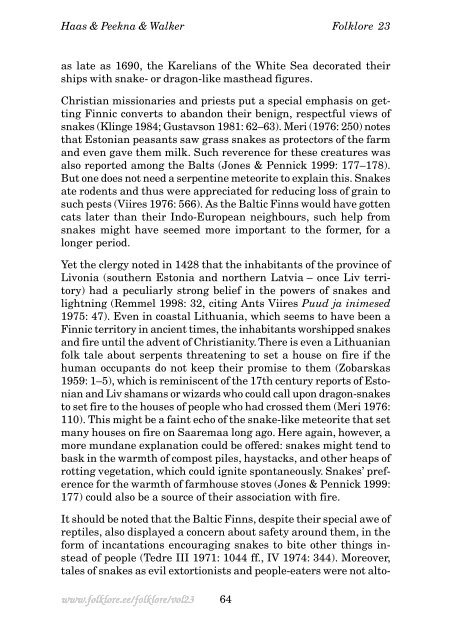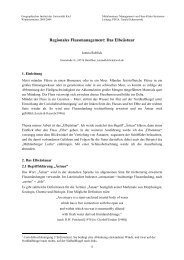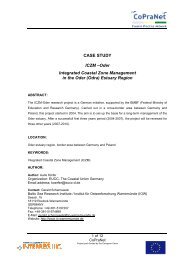View - IKZM-D Lernen
View - IKZM-D Lernen
View - IKZM-D Lernen
Create successful ePaper yourself
Turn your PDF publications into a flip-book with our unique Google optimized e-Paper software.
Haas & Peekna & Walker Folklore 23<br />
as late as 1690, the Karelians of the White Sea decorated their<br />
ships with snake- or dragon-like masthead figures.<br />
Christian missionaries and priests put a special emphasis on getting<br />
Finnic converts to abandon their benign, respectful views of<br />
snakes (Klinge 1984; Gustavson 1981: 62–63). Meri (1976: 250) notes<br />
that Estonian peasants saw grass snakes as protectors of the farm<br />
and even gave them milk. Such reverence for these creatures was<br />
also reported among the Balts (Jones & Pennick 1999: 177–178).<br />
But one does not need a serpentine meteorite to explain this. Snakes<br />
ate rodents and thus were appreciated for reducing loss of grain to<br />
such pests (Viires 1976: 566). As the Baltic Finns would have gotten<br />
cats later than their Indo-European neighbours, such help from<br />
snakes might have seemed more important to the former, for a<br />
longer period.<br />
Yet the clergy noted in 1428 that the inhabitants of the province of<br />
Livonia (southern Estonia and northern Latvia – once Liv territory)<br />
had a peculiarly strong belief in the powers of snakes and<br />
lightning (Remmel 1998: 32, citing Ants Viires Puud ja inimesed<br />
1975: 47). Even in coastal Lithuania, which seems to have been a<br />
Finnic territory in ancient times, the inhabitants worshipped snakes<br />
and fire until the advent of Christianity. There is even a Lithuanian<br />
folk tale about serpents threatening to set a house on fire if the<br />
human occupants do not keep their promise to them (Zobarskas<br />
1959: 1–5), which is reminiscent of the 17th century reports of Estonian<br />
and Liv shamans or wizards who could call upon dragon-snakes<br />
to set fire to the houses of people who had crossed them (Meri 1976:<br />
110). This might be a faint echo of the snake-like meteorite that set<br />
many houses on fire on Saaremaa long ago. Here again, however, a<br />
more mundane explanation could be offered: snakes might tend to<br />
bask in the warmth of compost piles, haystacks, and other heaps of<br />
rotting vegetation, which could ignite spontaneously. Snakes’ preference<br />
for the warmth of farmhouse stoves (Jones & Pennick 1999:<br />
177) could also be a source of their association with fire.<br />
It should be noted that the Baltic Finns, despite their special awe of<br />
reptiles, also displayed a concern about safety around them, in the<br />
form of incantations encouraging snakes to bite other things instead<br />
of people (Tedre III 1971: 1044 ff., IV 1974: 344). Moreover,<br />
tales of snakes as evil extortionists and people-eaters were not alto-<br />
www.folklore.ee/folklore/vol23<br />
64

















